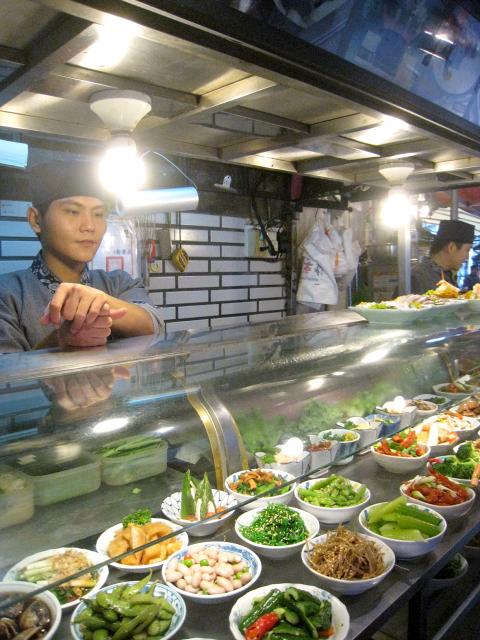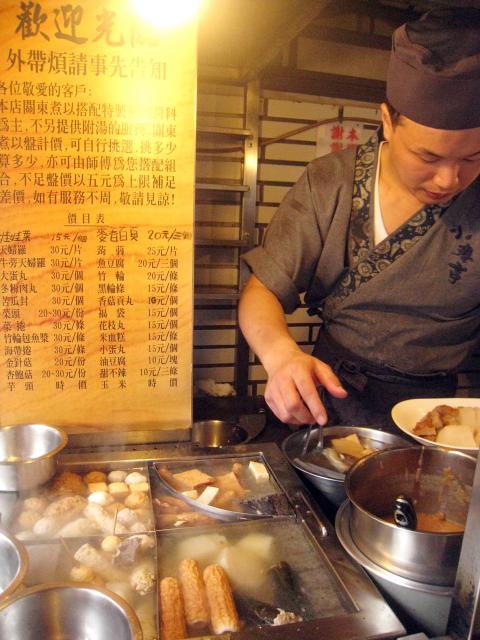In 2000, as a relative novice in the arts of food writing, I reviewed Hsiao Hsiang Ting (小巷亭) for the Taipei Times; even then it was a well-established eatery. In the proceeding 12 years, Taipei’s food scene has changed immensely. Top-notch Japanese and European restaurants have opened, and local chefs and restaurateurs, flush with experience gained from the finest establishments overseas, have set up luxury eateries all over town. But it is nice to know that some things don’t change; Hsiao Hsiang Ting is one of the city’s constants.
Taipei is a long way from rivaling Tokyo, Hong Kong or even Singapore as a regional culinary mecca, but there are some things it does particularly well. One of these is outstanding budget dining, a niche that is dwindling by the day, but still persists in the most unexpected places.
Hsiao Hsiang Ting opened in 1975 as an inexpensive Japanese restaurant catering to the cinema-goers who frequented the many movie theaters in the vicinity of the Nanjing West Road roundabout. Most of those theaters have now closed, but Hsiao Hsiang Ting is prospering.

Photo: Ian Bartholomew, Taipei Times
The restaurant’s forte is Taiwanese-style Japanese cuisine, with the Japanese influences coming primarily from the Osaka region, where founder Chen Te-cheng (陳德誠) got his training. This is reflected in Hsiao Hsiang Ting’s specialty, oden (黑輪), which is sold under the name kanto-ni (關東煮). A bowl that includes slow-cooked daikon, served in big chunks, tofu, and fish and meat balls and comes with a luscious miso accented dipping sauce (around NT$100), is one of the best examples of this popular street food to be found in the city.
A vast array of other dishes is laid out along stainless steel display cases.
Hsiao Hsiang Ting serves its fare buffet style, though the staff prepares sushi to order behind the counter. A plate of mixed sushi is around NT$150, and though purists might take exception to the heavy soy sauce coating, it’s very much in keeping with the restaurant’s bold flavors.

Photo: Ian Bartholomew, Taipei Times
Meat and fish such as eel are available. The grilled cod maw (鱈魚下巴) is particularly recommended.
To round out the meal there is a wide choice of colorful side dishes, some vegetarian, others made from seafood. You can always go back to the counter to pick up additional dishes, the bill calculated at the end when the plates on your table are tallied.
Located on the sidewalk and retaining something of a street food ambiance, the atmosphere at Hsiao Hsiang Ting is casual.
Though the restaurant looks like an overgrown street stall, the staff takes considerable care over the presentation of the food, and service is brisk and friendly.
Since the first review, the dining area has been moved from the street into either side of the alley: on one side a restaurant-like enclosed space, on the other, a few tables and chairs in an alcove.
There are certainly establishments that can boast far more authentic and sophisticated Japanese cuisine, but for a local food experience, Hsiao Hsiang Ting has few rivals.

June 9 to June 15 A photo of two men riding trendy high-wheel Penny-Farthing bicycles past a Qing Dynasty gate aptly captures the essence of Taipei in 1897 — a newly colonized city on the cusp of great change. The Japanese began making significant modifications to the cityscape in 1899, tearing down Qing-era structures, widening boulevards and installing Western-style infrastructure and buildings. The photographer, Minosuke Imamura, only spent a year in Taiwan as a cartographer for the governor-general’s office, but he left behind a treasure trove of 130 images showing life at the onset of Japanese rule, spanning July 1897 to

One of the most important gripes that Taiwanese have about the Democratic Progressive Party (DPP) is that it has failed to deliver concretely on higher wages, housing prices and other bread-and-butter issues. The parallel complaint is that the DPP cares only about glamor issues, such as removing markers of Chinese Nationalist Party (KMT) colonialism by renaming them, or what the KMT codes as “de-Sinification.” Once again, as a critical election looms, the DPP is presenting evidence for that charge. The KMT was quick to jump on the recent proposal of the Ministry of the Interior (MOI) to rename roads that symbolize

On the evening of June 1, Control Yuan Secretary-General Lee Chun-yi (李俊俋) apologized and resigned in disgrace. His crime was instructing his driver to use a Control Yuan vehicle to transport his dog to a pet grooming salon. The Control Yuan is the government branch that investigates, audits and impeaches government officials for, among other things, misuse of government funds, so his misuse of a government vehicle was highly inappropriate. If this story were told to anyone living in the golden era of swaggering gangsters, flashy nouveau riche businessmen, and corrupt “black gold” politics of the 1980s and 1990s, they would have laughed.

In an interview posted online by United Daily News (UDN) on May 26, current Chinese Nationalist Party (KMT) Chairman Eric Chu (朱立倫) was asked about Taichung Mayor Lu Shiow-yen (盧秀燕) replacing him as party chair. Though not yet officially running, by the customs of Taiwan politics, Lu has been signalling she is both running for party chair and to be the party’s 2028 presidential candidate. She told an international media outlet that she was considering a run. She also gave a speech in Keelung on national priorities and foreign affairs. For details, see the May 23 edition of this column,